BOOK EXCERPT—-
Hawaii– sun, sand beaches, sea breezes, snorkeling, palm trees and tourists everywhere, right? For that reason it was never high on my list of “must see” places… until I discovered Hawaiian jungle smallmouth.
Hawaii. Sun, sand beaches, sea breezes, snorkeling, palm trees… and tourists everywhere. These jewels in the Pacific sure have plenty of those, so it was never high on my list of “must see” places. But no man is an island, as they say, and Hawaii was on my wife’s bucket list. So I tepidly agreed, and found myself looking at those islands as an upcoming destination. It would be a big trip: multiple islands, volcanoes, helicopter tours, boat rides, scuba diving, luaus, hiking, waterfalls, beach time and more. We were really going to pack it all in.
This certainly wasn’t one of my usual fish-till-you-drop vacations and I wasn’t even planning to bring a rod… until I did a little on-line digging and uncovered Hawaiian smallmouth(!) Not just the a few private lakes that have a few smallies mixed in with bigmouth bass. No, what really caught my eye was the smallies in tiny jungle streams.
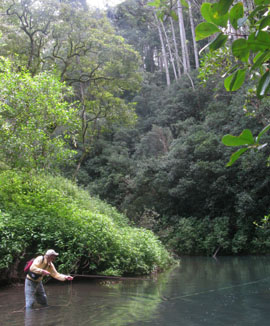
Working the Jungle Stream
Turns out, decades ago some enterprising folks brought over smallmouth bass from the mainland and released them in the small streams that tumble down the jungled mountains of Oahu’s interior. None of Hawaii’s islands are big, so many of these streams are only an hour or two from Honolulu/ Pearl Harbor and crowds in Hawaii’s largest city and biggest tourist attraction.
However, it isn’t just mainlanders who have never heard of this odd fishery; few on the islands have either. Hardly any Hawaiians seem to know or care about this small fishery. There are some transplanted trout anglers who formed a Trout Unlimited chapter, but don’t really have trout to catch, so some of them substitute smallmouth for trout and hike into these creeks to fish with light fly tackle. Their website was where I initially heard of these jungle bronzebacks, and after a little more investigation I decided to pack a fly rod and a few flies for the trip.
I’m really glad I did.
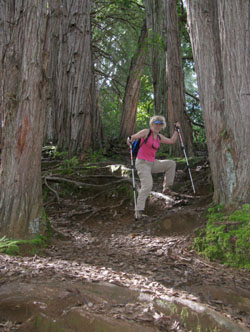
Paper-bark trees mark the trail
After several days doing tourist things on Oahu, one morning we headed inland. Following directions I had gotten, we drove past the town of Wahiawa and to a street of modest homes with woods on one side. Our tip just said to park on the street near the fence with an opening in it. A path from there led a short distance to a stand of paper-bark trees. The directions were very explicit about seeing those impressive trees (the shedding bark really is like paper) so I knew we were at the right place.
Now the fun began. The rough rocky trail led downhill into a heavily forested valley. But earlier hikers had tied the occasional ribbon on the trail so it was easy to follow. Going deeper into the valley the trail got muddy, and we had to jump across a tiny creek and hunch down to get under some fallen trees. We were both traveling light with just water, fruit, a little tackle, wading shoes and rain jackets. Which was a very good idea. We heard the Koolau Mountain Range catches the clouds, so it rains huge amounts annually, with some rain almost daily. True to the prediction, just before we got to the stream the rains came. It made the trail muddier, but Hawaii temps are almost always warm, so wet legs and a dry torso wasn’t too bad.
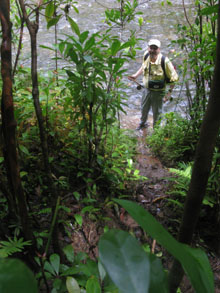
The end of the jungle trail
More of a challenge was just ahead. After a 40-minute hike we could see water through the thick vegetation. But it was way below us, and it turned out the final 30 feet was a steep drop-off in the thick vegetation. While the rain continued to fall, we discovered the “angler elevator” to the stream. Some enterprising soul had hiked in an old garden hose, tied it a stout tree and threw the loose end over the muddy cliff. This was our route down to the water.
Lyn is a very fit and hardy gal who loves hiking, but this seemed a little much even for her. Only after I tested the “rope” and promised to catch her if she lost her grip on the wet hose, did she consent to follow me down. It was muddy, there was some slipping and sliding (and colorful words) but we made it to the streamside. And what a stream. Perhaps 25 feet wide and a foot deep, it had good clarity, gravel bottom and banks lined with a profusion of strange-looking trees, bushes and tall grasses, none of which I had ever seen before. Just up ahead the stream made a sharp turn and the deeper-looking outside bend held a log.
Even the rain had stopped, so we stowed the rain jackets back into our small pack and pulled out wading shoes. Both the air and water was near 80 degrees, so wet-wading felt good on the legs. Man, was this shaping up to be a great jungle adventure or what?
Excitedly, I quickly assembled my four-piece rod and strung the line. Thinking white (often my first fly color) I eased towards the bottom of the outside bend and made a cast. If this was a TV show, my first cast would be rewarded with a big strike… but reality said no. After unsuccessfully working that spot, I waded around the bend to find a riffle flowing into a small pool. No strikes there either, so I decided to switch to basic black.
The next pool upstream was considerably larger and looked several feet deep, plus it had a downed tree in it. Well, this seemed to have “FISH” written in bold on it. But still no action from the bottom of the pool, so I stayed low and sneaked into position in the riffle at the top of the pool. Now I could let the current push my Shenks Streamer fly under the log and I twitched it back.
Bingo! On the second cast a swirl, a yank and a spirited fight.
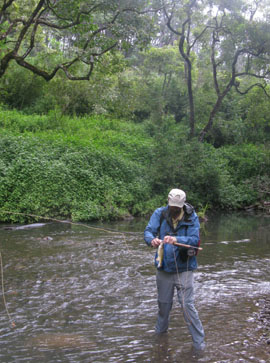
Tim’s first Hawaiian smallmouth bass
Okay, the fight wasn’t that long, since my first jungle smallie was barely 9 inches. Now let me mention here why not many anglers care about these island fish. They run small, very small. The Hawaiian Islands are far out in the Pacific and are fairly new, so the freshwater streams have almost no native fish species, no crayfish and very limited insect life. In most of the dozen extremely infertile streams that smallmouth have populated they always remain very small, and the few that exceed a foot are prized trophies. Sort of like mainland brook trout in many tiny creeks.
But the exotic setting was absolutely spectacular and not another person was around. I was happy, and Lyn was content to take photos and observe the flora and bird life. I worked my way upstream another 600 yards and caught a few more of those sleek little beauties along the way, but I never broke 10 inches.
Before we turned around and started back, we sat on a log with that mountain stream gurgling around our feet. I can’t remember when I’ve enjoyed a streamside lunch more, of just oranges, granola bars and 80-degree water. Volcanoes on the Big Island, scuba diving among colorful salt species, and spectacular Kawai waterfalls lay ahead, but this day in the jungle stalking those little fish rates right up there in my favorite Hawaii memories.
— Excerpted from the book “Adventures of a Fishing Bum — 27 True Tales.”
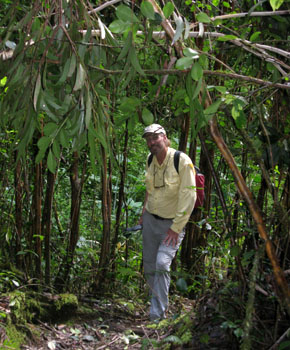
Tim hiking the jungle trail
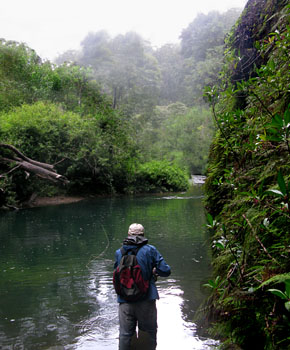
Tim working a big pool, beside a wall of exotic vegetation
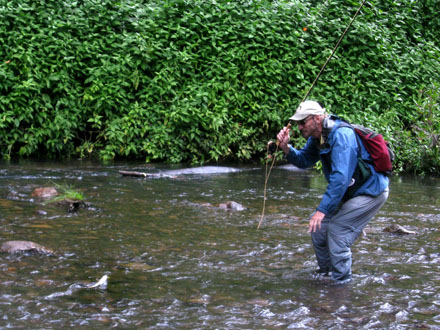
Landing a Hawaiian smallmouth bass
Read More Adventure Tales:


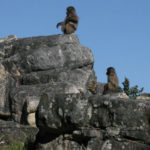
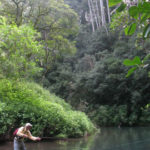
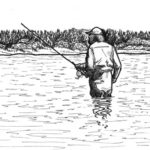
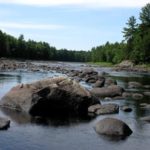
No comments yet.